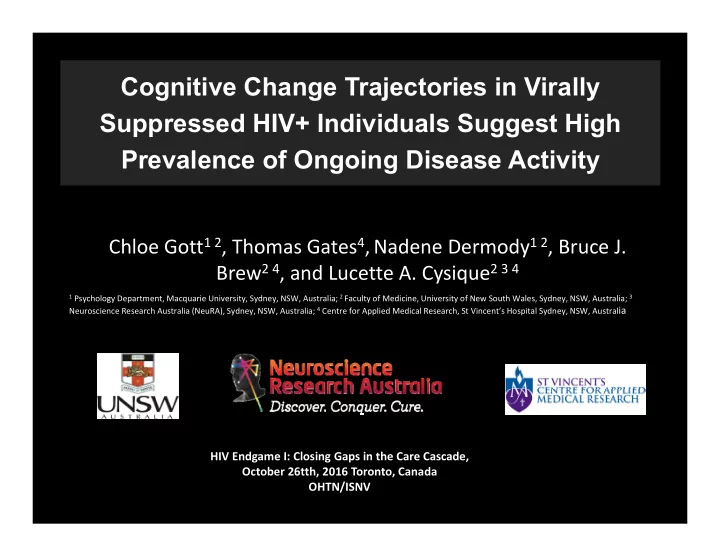

Cognitive Change Trajectories in Virally Suppressed HIV+ Individuals Suggest High Prevalence of Ongoing Disease Activity Chloe Gott 1 2 , Thomas Gates 4 , Nadene Dermody 1 2 , Bruce J. Brew 2 4 , and Lucette A. Cysique 2 3 4 1 Psychology Department, Macquarie University, Sydney, NSW, Australia; 2 Faculty of Medicine, University of New South Wales, Sydney, NSW, Australia; 3 Neuroscience Research Australia (NeuRA), Sydney, NSW, Australia; 4 Centre for Applied Medical Research, St Vincent’s Hospital Sydney, NSW, Austral ia HIV Endgame I: Closing Gaps in the Care Cascade, October 26tth, 2016 Toronto, Canada OHTN/ISNV
Presenter Disclosure • Presenter: Lucette Cysique • Relationships with commercial interests • Grants/Research support: Gilead Science • Speakers Honoraria: none • Consulting Fees: none • Other: none
Introduction • Lack of research examining NP changes in individuals with long‐term viral suppression • In this context, HAND is mostly characterized by ANI and MND • Previous studies in cART‐treated patients (N=9) used various definition of cognitive decline: • Low clinical relevance • No practice effect correction • Absorbing rate vs. multiple rate in multiple study visit • Single tests or very short NP batteries (tests N=3) • None of the studies took into account Historical HAND diagnosis
Study aims 1. To quantify the rate of incident neurocognitive decline in chronic treated HIV+ persons relative to healthy controls of the same age over an 18‐month period based on a test battery that assessed seven cognitive domains 2. To investigate the historical and baseline cognitive determinants of cognitive decline and to determine the profile of cognitive trajectories in functions of historical and baseline HAND status. 3. To determine whether standard HIV disease biomarkers & cART factors contribute to cognitive decline.
Baseline study participants HIV+ (6% attrition); HIV‐ (12% attrition) Follow‐up assessment ~ 18 months: mean test‐retest interval=19.56 months, SD= 7.73 months. No significant difference between retained & LTFU except for : A higher proportion of HIV+ participants LTFU had HAND at baseline (100%) compared to those retained (55%) (p=.03)
HIV+ sample HIV disease characteristics 88% of HIV+ participants had undetectable viral loads during the study period For the remainder, viral detection was in the form of viral blips (median 150 cp/mL, IQR:100‐345) Except for 1 single case of HIV replication beyond blip level who had to stop cART before a specific medical intervention.
NP test battery
Historical HAND; Baseline HAND & Cognitive Decline Historical HAND Adapted to the HAND 2007 criteria by LC, and reviewed by BJB to reach diagnoses of MND and HAD . Past HAND status was analyzed as a dichotomous variable (yes/no) Baseline HAND • Frascati HAND classification • GDS≥ 0.5 & no IADL decline = ANI • GDS≥ 0.5 & mild/moderate IADL decline = MND • GDS≥ 1.5 & severe IADL decline = HAD • Baseline performance was also analyzed using the mean scaled score Cognitive Decline • Based on standard regression‐based norms correcting for PE, demographics, baseline performance and overall competence • Individual change score averaged into a summary regression‐based changed score • The summary based change score is like a z‐score with a mean of 0 and a SD of 1 • Clinically significant decline (yes/no) based on a 95% IC around normative mean
Results: Incident cognitive decline A greater proportion of HIV+ ( 14.0% ) participants declined as compared to HIV‐ cases ( 4.5% ) (non‐significant difference: p =.11, Φ= .13
Results: Determinants of cognitive decline at group level Baseline HAND and historical HAND were significantly related, wherein participants who had historical HAND were more likely to also have baseline HAND ( p =.035). Baseline performance: β=.86; p <.0001 HAND Hx: 0.06; p =.29 Interaction: =‐0.07; p =.27
Results: HIV; age; HIV*age interaction & cognitive decline There was no significant HIV status * Age interaction effects (β=‐0.07; p=0.50) on the summary change score, or the psychomotor, or the mental flexibility change score In these models, age remained an independent predictor for verbal fluency (β=‐0.21; p=0.04) and the summary change score (β=‐0.20; p=0.05) Yet, we note that in the same cohort there was a HIV*age effect on reduced neuronal integrity in the frontal white matter assessed by 1 H MRS.
Results: Individual Trajectories of Cognitive Decline %
Results: cognitive decline & HIV disease, cART markers • There was no relationship between cognitive decline (taking into account historical and baseline HAND) and traditional HIV disease biomarkers. • Nadir CD4+ T cell count (p=.68) • Current CD4+T cell count(p=.16) • standardized difference CD4+T cell count (p=.72) • Virologically undetectable during study period (yes/no; p=.72) • Baseline HIV duration (p=.73) • Baseline cART duration in months (p=.48) %
Conclusions • Despite long‐term viral suppression and immune recovery, our study demonstrates mostly subclinical levels of decline in psychomotor speed and executive functioning. • These functions are markers of HAND progression. • 57% of our cohort is undergoing some evolution of their disease challenging the notion of neurocognitive stability in virally suppressed HIV+ persons. • Have we identified slow progression of mostly subclinical deficits? • Confirmation in larger and more diverse HIV cohorts will be important (+ women; more diverse cohort being currently recruited) % • No effect of HIV* age & question of survivor bias & NP versus Imaging
Acknowledgements We would like to thank the participants for their time. The study was funding by the NHMRC project grant (APP568746; CIA/PI Cysique) and NHMRC Career Development Fellowship (APP1045400; CIA/PI Cysique), and the support of the Peter Duncan Neuroscience Unit at St. Vincent’s Hospital Applied Medical Research Centre (Director: Prof. Brew) Thank you for your attention
Recommend
More recommend